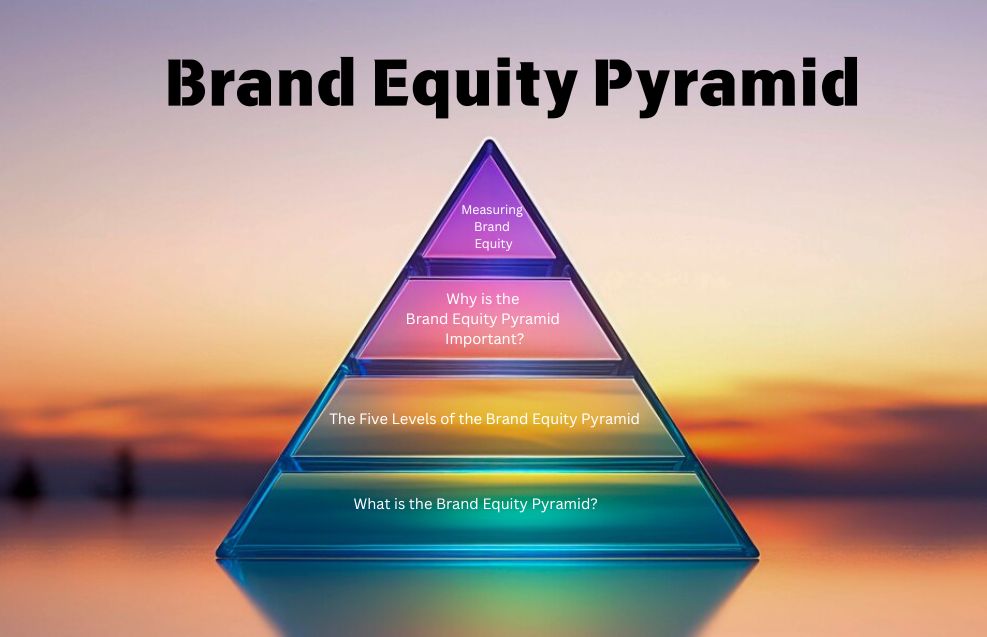In the competitive world of marketing, understanding and managing your brand’s value is key to ensuring long-term success. One powerful concept that marketers rely on to build, analyze, and sustain this value is the brand equity pyramid. This pyramid is a framework that helps companies map their brand’s relationship with consumers, ultimately guiding efforts to enhance customer loyalty, trust, and overall brand strength. In this blog post, we will explore the brand equity pyramid, its different levels, and how you can apply this model to strengthen your brand’s position in the market.
What is the Brand Equity Pyramid?
The brand equity pyramid is a strategic tool used to assess the development and growth of a brand. It consists of several levels that represent different stages in building brand value, with each stage focusing on increasing customer loyalty, satisfaction, and affinity for the brand. The pyramid starts with basic brand awareness at the bottom and culminates with deep emotional connections at the top.
This model is based on the concept that a brand’s equity increases as it moves up the pyramid. Each level builds upon the previous one, and the ultimate goal is to reach the top level, where the brand enjoys high loyalty and advocacy from customers. Let’s break down the levels of the brand equity pyramid and explore how real-world companies have successfully navigated through these stages.
The Five Levels of the Brand Equity Pyramid
1. Brand Awareness
At the base of the brand equity pyramid lies brand awareness. This is the foundational level where customers first become aware of your brand. Awareness can take different forms, from simple recognition to a deeper understanding of what your brand stands for. At this stage, your brand is not yet top-of-mind for consumers, but it’s a necessary first step toward building any meaningful connection with them.
Real-World Example: Consider how Coca-Cola has built brand awareness across the globe. Through decades of consistent advertising campaigns, its red-and-white branding is now instantly recognizable. Coca-Cola uses a combination of traditional advertising, sponsorships, and global events to ensure it remains at the forefront of consumers’ minds.
Brand awareness is about ensuring that your target audience knows your brand exists. This could be achieved through various channels like advertising, social media presence, and word-of-mouth. The goal is to reach as many potential customers as possible to get your brand on their radar.
2. Brand Association
Once awareness is established, the next level of the brand equity pyramid is brand association. This stage involves the creation of a positive mental image that consumers link with your brand. For example, when customers think of your brand, they should associate it with certain qualities, emotions, or experiences that align with your values.
Real-World Example: Nike has successfully created a strong brand association with concepts like athleticism, empowerment, and victory. Their “Just Do It” campaign and the use of iconic athletes in their advertisements cement Nike’s reputation as a brand that stands for personal achievement and overcoming obstacles.
The key to building strong brand associations is consistent messaging. Whether it’s through storytelling, visuals, or brand voice, your company’s messaging should reinforce the qualities you want your customers to associate with your brand. This helps to create a strong mental link in their minds, distinguishing your brand from competitors.
3. Perceived Quality
Moving up the brand equity pyramid, the next level is perceived quality. At this point, customers begin to evaluate the brand not just based on their mental associations but on how they perceive its overall quality. This could be in terms of product durability, customer service, and overall satisfaction.
Real-World Example: Apple is an excellent example of a brand that has worked hard to build strong perceptions of quality. Their sleek design, premium pricing, and seamless integration of hardware and software have led consumers to associate Apple with superior quality and innovation. Even though there are competitors with similar products, Apple’s consistent delivery of high-quality experiences continues to reinforce its perception as a premium brand.
Perceived quality is critical because customers tend to lean toward brands that they believe offer higher quality, whether real or perceived. A high-quality perception can lead to more repeat purchases and customer loyalty, which are essential for long-term success. Therefore, it’s important to consistently deliver on your brand promises and improve product features to maintain a positive perception of quality.
4. Brand Loyalty
The next stage in the brand equity pyramid is brand loyalty, where customers develop a preference for your brand. They not only recognize your brand, but they also choose it over competitors because of the positive associations and perceived quality you have established. At this point, customers are more likely to make repeat purchases and even defend your brand when others try to persuade them otherwise.
Real-World Example: Starbucks is a prime example of a brand that has cultivated significant brand loyalty. With its personalized customer service, loyalty programs, and strong brand community, Starbucks has created a loyal customer base that returns consistently. The convenience of the mobile app and rewards program further strengthens loyalty by rewarding customers for their continued patronage.
Brand loyalty is often the result of consistently exceeding customer expectations and building trust over time. Loyalty can also be strengthened through reward programs, personalized experiences, and regular engagement with customers. The more loyal customers are, the more likely they are to remain advocates for your brand, bringing in new customers through word-of-mouth.
5. Brand Resonance
At the pinnacle of the brand equity pyramid lies brand resonance, the ultimate goal for any company. Brand resonance is a deep, emotional connection with customers that goes beyond mere preference or loyalty. At this level, customers don’t just purchase from you because they trust the brand or are satisfied with its quality—they have an emotional attachment to your brand.
Real-World Example: Harley-Davidson has mastered the art of brand resonance. Its customers often feel a deep connection to the brand, identifying themselves with its rebellious spirit and the freedom associated with motorcycle riding. The Harley-Davidson community is so passionate that it creates a sense of belonging and identity for its owners.
Brand resonance is what turns customers into passionate brand advocates. They identify with your brand on a personal level and are willing to share their positive experiences with others. To achieve brand resonance, a company must engage customers in meaningful ways that align with their values, lifestyle, or personal identity. Companies that successfully reach this stage often see customers go beyond transactional relationships and develop a long-term commitment to their brand.
Why is the Brand Equity Pyramid Important?
The brand equity pyramid is important because it gives businesses a clear roadmap for building and sustaining brand value. By understanding where your brand stands on the pyramid, you can better identify areas of improvement and focus your marketing efforts accordingly. For example, if your brand is stuck at the awareness stage, your efforts should be focused on increasing recognition through advertising and content marketing. On the other hand, if your brand is struggling with loyalty, it’s essential to focus on customer satisfaction and engagement strategies.
By moving through the stages of the brand equity pyramid, you can enhance customer retention, increase perceived value, and build a strong foundation for long-term success. Moreover, understanding brand equity allows businesses to invest more wisely in branding strategies and marketing campaigns that resonate with their target audience.
Building Brand Equity Using the Pyramid Model
Now that we understand the different stages of the brand equity pyramid, let’s dive into how you can apply this model to your brand’s growth.
- Start with Strong Brand Awareness
Before building customer loyalty or emotional connections, your first priority should be creating brand awareness. Utilize social media platforms, digital advertising, content marketing, and influencer partnerships to ensure that potential customers recognize your brand. Focus on providing value in every interaction to help customers remember your brand. - Create Positive Brand Associations
As your brand becomes more widely known, it’s time to focus on building positive associations. Consider what sets your brand apart and make sure those qualities are reflected in your messaging. Whether it’s luxury, affordability, sustainability, or innovation, your brand should consistently convey its unique selling points. - Invest in Perceived Quality
To build credibility, invest in delivering high-quality products or services. Ensure that your customer experience is top-notch and that your offerings meet or exceed customer expectations. When people believe your brand provides superior value, they are more likely to remain loyal to it. - Focus on Customer Loyalty
Building loyalty is crucial for long-term brand equity. Offer incentives like loyalty programs, personalized marketing, or special offers to keep customers coming back. Additionally, pay attention to customer feedback and respond to their needs to ensure they remain satisfied. - Cultivate Brand Resonance
The final goal of the brand equity pyramid is to achieve brand resonance. To do this, go beyond transactional relationships and connect with your customers on an emotional level. Build community, engage with your customers through various channels, and align your brand with their core values.
Measuring Brand Equity
To effectively use the brand equity pyramid in your strategy, it’s essential to measure your brand’s position on the pyramid regularly. Key performance indicators (KPIs) like brand awareness surveys, customer satisfaction rates, and Net Promoter Score (NPS) can give you valuable insights into how your brand is performing at each level.
Conclusion
In conclusion, the brand equity pyramid offers a valuable framework for understanding the development and growth of your brand. By focusing on increasing awareness, building positive associations, enhancing perceived quality, fostering loyalty, and achieving brand resonance, you can establish a strong, enduring brand. The journey up the brand equity pyramid is not always easy, but with the right strategies in place, your brand can rise to the top, becoming a powerful force in your industry. Whether you’re just starting or looking to improve your brand’s position, the brand equity pyramid is a crucial tool for creating lasting value and achieving long-term success.

